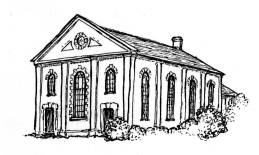| The
Non Conformists Chapels in the Glasbury Area
This article was prepared by M. A. V. Gill in 2005 for the "Glasbury Book" (unpublished), It was first published with annotations in Brycheiniog Vol XVIII 2012 . The excellent artwork is also by the same local author |
NONCONFORMIST CHAPELS AND MEETINGHOUSES In a period when so many Nonconformist chapels throughout Wales are being made redundant and demolished or converted to secular use, no fewer than three in the parish of Glasbury appear in Anthony Jones’ monograph Welsh Chapels (1984), listed as buildings which should be “saved at all costs”: Maesyronen, Capel-y-ffin and Treble Hill, each representative of a different period and style of chapel building. In J.W. Hobbs’ reminiscences, he describes the Chapel Sunday school Anniversaries as great events, when children and adults would give songs and recitations: “One year a grand ‘Dialogue’ was given by the men of the Chapel. It was called ‘Noah’s Ark’ and the part of the patriarch was taken by the white haired old stationmaster, Mr. Jones. There were about a dozen men and boys taking part, but the only two names I remember were a Mr. Holder and the jovial old Precentor, Mr. James Morgan, who added a touch of humour by rushing in, getting stage fright and instead of the grandiloquent speech he should have delivered, looking blankly around and then blurting out, ‘the river has ruz, and I’m feared as most of my ships have been washed away’. I was a sinner who repented and arrived after Noah had entered the Ark (the Chapel vestry), and heard the solemn words from inside ‘Too late, too late, the door is shut, you cannot enter now!’”. TREBLE HILL BAPTIST CHAPEL
In 1861 the Baptist cause in Glasbury was revived. The church sharing a minister with Pen-yr-heol, a local “warehouse” was hired as a meetinghouse. On 12th February 1862, a lecture accompanied by a concert was delivered in the Baptist place of worship, on the subject of “The Millennium”. The speaker examined the scriptural evidence and concluded that the prophecies meant the event would occur “about the year 2,000, or at the end of the sixth thousand years of the world’s history”, and “upon the seventh thousand years, the sabbath of peace and joy will begin”. The meeting lasted for about five hours, but the attention of the large audience was “well sustained”! The lecture was probably given in one of the old Treble Hill wool warehouses. This location would agree with the vague description contained in an account of the opening services of the new chapel in 1867 when the afternoon service was held in the open air: “The active friends had prepared seats and erected a temporary platform for the occasion, on a beautiful site for such a gathering. Behind was the old room in which the Baptists have met for divine worship for many years, and though it has nothing attractive in its appearance or imposing in its style, yet undoubtedly the place is sacred to the memory of many friends in the locality”. Earlier attempts to build a chapel had failed, as a suitable site
could not be procured; now Benjamin Piercy (owner of the Treble
Hill estate) provided a site next to the bridge. Plans were prepared
by John Lewis of Glasbury and embellished by Piercy’s own
architect; the contractors for the erection of the building and
its fittings were James Lewis and Thomas Hughes. On 26th June 1866
the foundation stone was laid and exactly a year later (25th June
1867) Treble Hill Baptist chapel was formally opened. It was a very
modern building, in Classical style, using brick with stone dressings
in its construction, a combination of materials facilitated by the
recent opening of the Hereford, Hay and Brecon railway. A feature
that impressed at the time (and still impresses) was the light “so
bountifully supplied… from Moline’s patent wrought iron
windows, with Moore’s patent ventilators”.
|
 On
14th January 1792 a petition was made to the Bishop for the licensing
of the “Dwelling house of William Mitchell, called Tilly Mawr,
parish Glasbury” as a place of worship for Protestant dissenters
(probably Baptists); then a similar petition was submitted on 5th
March 1800 for “Brynsicriog”, both farms north of the
river. For some years in the 1820s, Baptist meetings were held nearby
in the farmhouse at Llwynpenderi, where the farm manager was a member
of the Pen-yr-heol church. About 1830 John Jenkins left and was
succeeded by Thomas Davis, who also became a Baptist. Then, when
he moved to Cilkenny Farm, meetings were held alternate Sundays
at Cilkenny and Talymawr, until Davis again moved on (to Boughrood).
For a time meetings were held in one of the houses at Ffynnon Gynydd,
but around 1859 the tenant moved out, the house itself was shut
up and for two years no meetings were held in the neighbourhood.
On
14th January 1792 a petition was made to the Bishop for the licensing
of the “Dwelling house of William Mitchell, called Tilly Mawr,
parish Glasbury” as a place of worship for Protestant dissenters
(probably Baptists); then a similar petition was submitted on 5th
March 1800 for “Brynsicriog”, both farms north of the
river. For some years in the 1820s, Baptist meetings were held nearby
in the farmhouse at Llwynpenderi, where the farm manager was a member
of the Pen-yr-heol church. About 1830 John Jenkins left and was
succeeded by Thomas Davis, who also became a Baptist. Then, when
he moved to Cilkenny Farm, meetings were held alternate Sundays
at Cilkenny and Talymawr, until Davis again moved on (to Boughrood).
For a time meetings were held in one of the houses at Ffynnon Gynydd,
but around 1859 the tenant moved out, the house itself was shut
up and for two years no meetings were held in the neighbourhood.